[ad_1]
The upper lower split (short for “upper body lower body split”) is a workout routine that separates your workouts into two types: upper-body and lower-body workouts.
Upper lower split routines are popular because they’re simple, flexible, and effective. Provided they’re well-designed, they also allow you to train your entire body efficiently without ever overextending yourself.
As is the case with any training split, though, you have to know how to “program” your workouts correctly. Focus on the wrong exercises or include excessive sets and reps, and you run the risk of overtraining or getting injured.
In this article, you’ll learn everything you need to know about the upper lower split, including what it is, why it’s beneficial, the best 3-, 4-, and 5-day upper lower split routines for gaining muscle and strength, and more.
What Is an Upper Lower Split?
The upper lower split (often written “upper/lower split”) is a training routine that divides your workouts into upper- and lower-body workouts.
In upper-body workouts, you train all of the muscle groups in your upper body, including your chest, shoulders, back, and arms.
In lower-body workouts, you train all of the muscle groups in your lower body, including your quads, hamstrings, glutes, and calves.
Traditionally, the upper lower split is a 4-day routine with two upper- and two lower-body workouts each week.
That said, the upper lower split routine is flexible, so you can easily rearrange workouts into a 2-, 3-, or 5-day upper lower split if this better suits your schedule and goals.
Upper Lower Split Routine Benefits
1. It trains your entire body.
A common beginner mistake is dedicating too much time to training the “mirror muscles”—the pecs, shoulders, and biceps—and neglecting the back, triceps, and legs.
This creates size and strength muscle imbalances between the back and front and upper and lower portions of your body, which spoil your “aesthetics” and may increase your risk of injury.
The upper lower split helps you avoid this issue by ensuring you train all of your major muscle groups proportionally.
2. It allows you to train all of your muscles at least twice per week.
Many workout routines have you train just one muscle group per workout. While this can work in some circumstances, research shows that training your muscles more than once a week is likely better for gaining muscle and strength.
Upper lower split workout routines typically contain at least two upper-body workouts and at least two lower-body workouts each week, making them highly effective at helping you build muscle and get stronger.
(And if you’d like even more specific advice about how often you should train, how many sets you should do each week, and what exercises you should do to reach your health and fitness goals, take the Legion Strength Training Quiz, and in less than a minute, you’ll know the perfect strength training program for you. Click here to check it out.)
3. It ensures your training is high-quality.
When you train just one muscle group per workout, its performance usually begins to plummet before your workout is finished. This means you have to compensate by using lighter weights or doing fewer reps in your later sets, which stymies your progress over time.
With the upper lower split, you never train any one muscle group to the point of exhaustion. This allows you to perform high-quality reps with heavy weights, which is generally better for building muscle and gaining strength.
4. It limits soreness and fatigue.
Because you never train your muscles to exhaustion while following an upper lower split, you minimize soreness and cumulative fatigue.
For example, if you follow a body-part split and “crush” your chest on Monday, your triceps and delts may still be sore when it’s time for your shoulder workout on Wednesday, which will likely limit your performance.
When you follow an upper lower split, you experience less muscle soreness and fatigue from individual training sessions, and your training at the end of the week isn’t negatively affected by the workouts you did earlier in the week.
5. It allows for plenty of rest.
Research shows that after you train a muscle, it’s best to wait around 48 hours before you train it again.
There are two primary reasons for this:
- It reduces your risk of injury (especially repetitive strain injuries).
- It ensures you can give maximal effort in your workouts, which helps with progressive tension overload.
In any well-designed upper lower split routine (like those included below), each of your major muscle groups will get at least two-to-four days of rest between workouts.
The Best Upper Lower Split for Mass
The following are tried-and-tested 3-, 4-, and 5-day upper lower splits.
The reason they work so well is that they have you doing all the best compound exercises and they use the right number of weekly sets to promote muscle and strength gain without wearing you to a frazzle.
3-Day Upper Lower Split
If you’re a beginner, need a lot of time to recover, or have a busy schedule, a 3-day upper lower split is an excellent solution.
Below are two 3-day upper lower splits: One that emphasizes the upper body and another that emphasizes the lower body. Choose whichever suits your goals best, or alternate between them every 8-to-10 weeks of training. For both routines, leave at least one day of rest between each workout
Note: The deadlift features in both versions of the 3-day upper lower split on upper- and lower-body days. This isn’t a mistake—the deadlift trains your entire posterior chain (all the muscles on the back of your body), which means it fits nicely into both upper- and lower-body workouts.
Here’s the 3-day upper lower split that emphasizes the upper body:
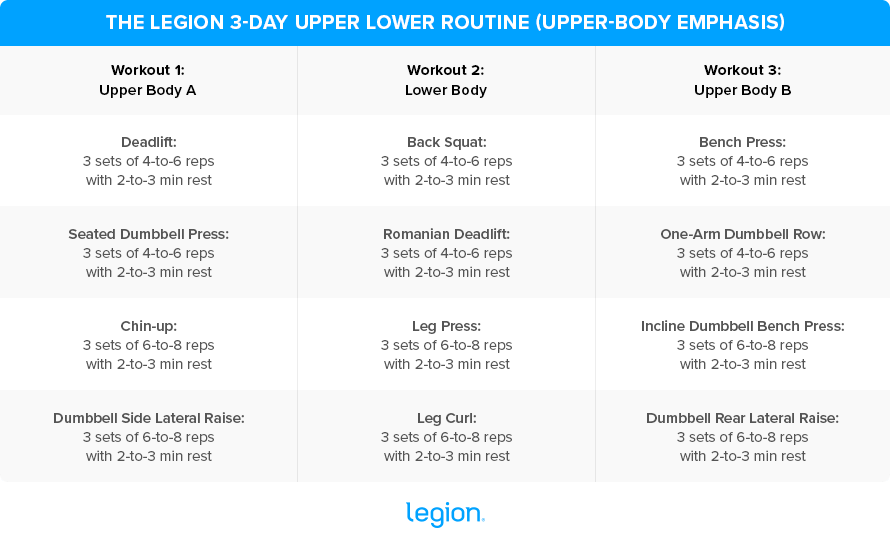
And here’s the 3-day upper lower split that emphasizes the lower body:
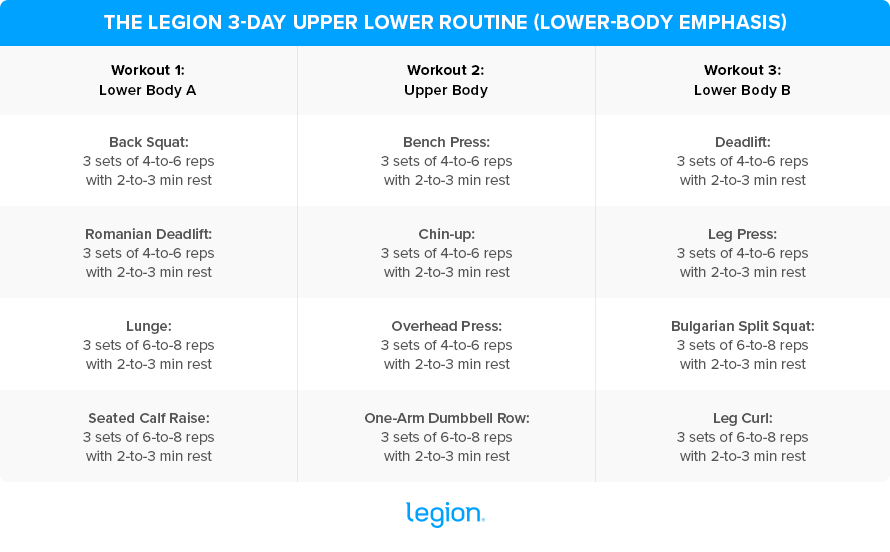
4-Day Upper Lower Split
The 4-day upper lower split is the default version of the upper lower split. It’s popular with everyone from beginners to advanced weightlifters because it allows you to do plenty of volume (sets and reps) for all of your muscle groups, which is beneficial for helping you gain full-body muscle and strength, but it also includes three rest days per week, which is ample.
The best way to schedule the upper lower 4-day split is to do workouts 1 and 2 on consecutive days, take a rest day, then do workouts 3 and 4 on the next two consecutive days, followed by two rest days.
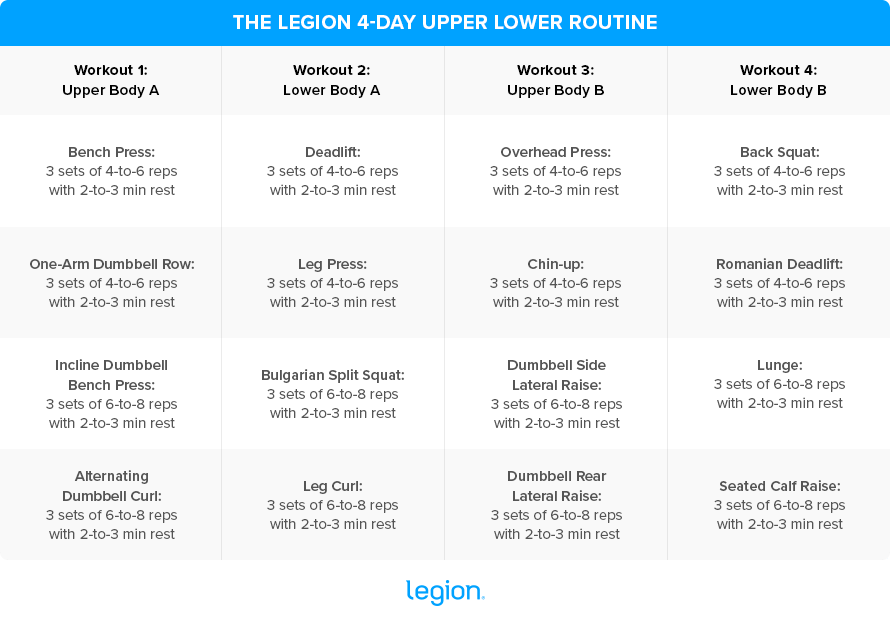
5-Day Upper Lower Split
The 5-day upper lower split is overkill for beginners, but it can be useful for intermediate and advanced weightlifters in certain circumstances. For example, you could use the following 5-day upper lower split to maximize muscle and strength gains during a bulk, or to temporarily increase your weekly volume to help you break through a weightlifting plateau.
Like with the 3-day upper lower routine, there are two versions: one that emphasizes your upper body and one that emphasizes your lower body.
Here’s the 5-day upper lower split that emphasizes the upper body:
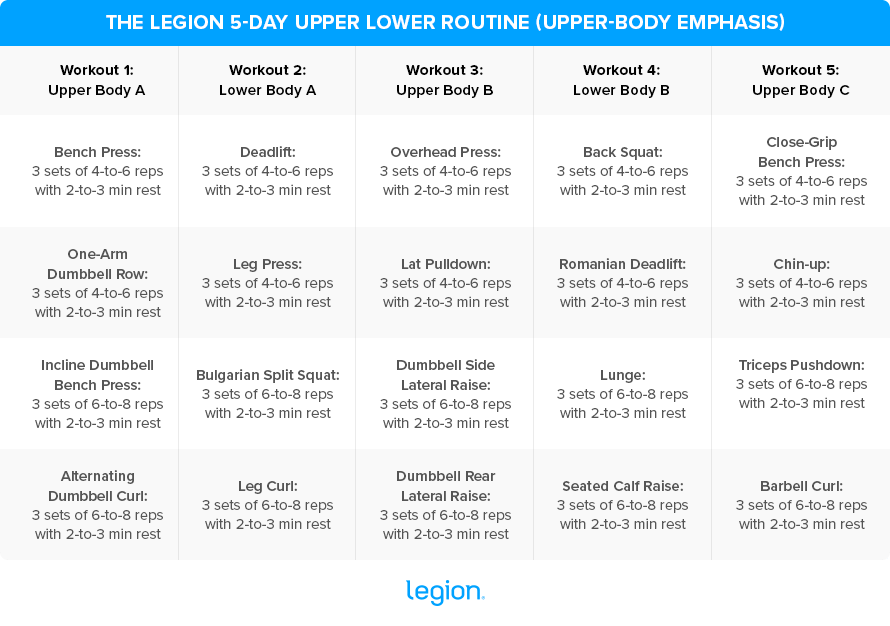
And here’s the 5-day upper lower split that emphasizes the lower body:
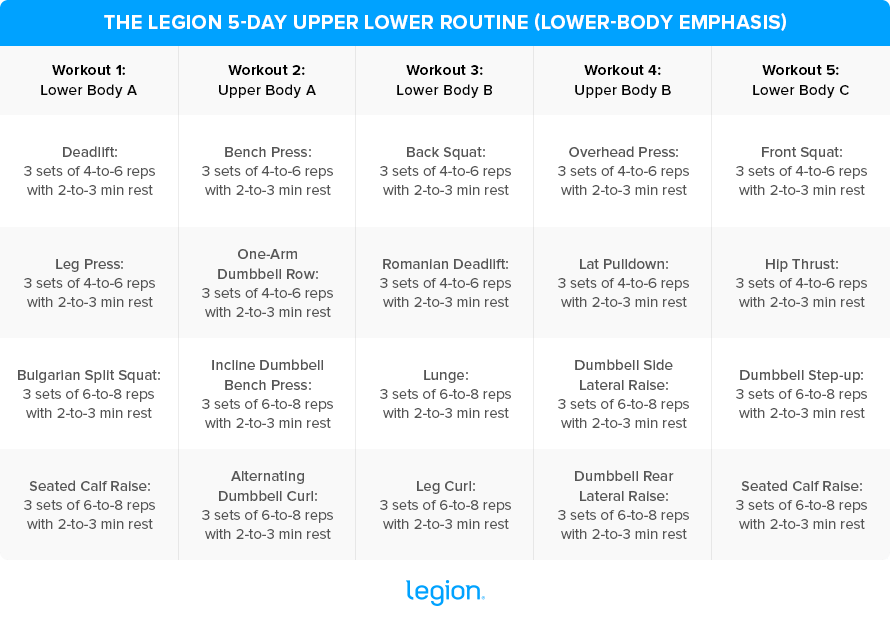
3 Tips for More Productive Upper Lower Split Workouts
1. End every set 1-to-3 reps shy of muscle failure.
In order to maximize muscle and strength gains, you need to take most of your sets close (but not all the way) to muscle failure, which is the point at which you can’t complete a rep despite giving maximum effort.
To ensure you’re taking your sets close enough to failure, ask yourself this question at the end of each set, just before re-racking the weight: “If I absolutely had to, how many more reps could I get with good form?”
If the answer is more than two, then you should increase the weight or reps to make your next set more challenging. This ensures you’re including the right balance of volume and intensity in your upper lower split workouts.
2. Once you hit the top of your rep range for a set, move up in weight.
For instance, let’s say your workout calls for 4-to-6 reps of the deadlift. If you get 6 reps on one set, add 5 pounds to each side of the bar (10 pounds total) for your next set and work with that weight until you can (eventually) pull it for 6 reps, and so forth.
If you get 3 or fewer reps with your new (higher) weight on your next sets, reduce the weight by 5 pounds to ensure you can stay within your target rep range (4-to-6) for all sets.
Follow this same pattern of trying to add reps or weight to every exercise in every workout. This method is known as double progression, and it’s a highly effective way to get fitter and stronger.
3. Take the right supplements
Unfortunately, no amount of pills and powders are going to give you a “godlike” physique. In fact, most muscle-building supplements are completely worthless.
But here’s the good news: if you know how to eat and train to build muscle, certain supplements can speed up the process.
(And if you’d like specific advice about which supplements you should take to reach your health and fitness goals, take the Legion Supplement Finder Quiz, and in less than a minute, you’ll know exactly what supplements are right for you. Click here to check it out.)
Here are the best supplements for supporting your upper lower workouts:
- 0.8-to-1.2 grams of protein per pound of body weight per day. This provides your body with the “building blocks” it needs to build and repair muscle tissue and help you recover from your workouts. If you want a clean, convenient, and delicious source of protein, try Whey+ or Casein+.
- 3-to-5 grams of creatine per day. This will boost muscle and strength gain, improve anaerobic endurance, and reduce muscle damage and soreness from your pull workouts. If you want a 100% natural source of creatine that also includes two other ingredients that will help boost muscle growth and improve recovery, try Recharge.
- One serving of Pulse per day. Pulse is a 100% natural pre-workout drink that enhances energy, mood, and focus; increases strength and endurance; and reduces fatigue. You can also get Pulse with caffeine or without.
+ Scientific References
- Phil Page, P. P. A. L. C. F. (2011). SHOULDER MUSCLE IMBALANCE AND SUBACROMIAL IMPINGEMENT SYNDROME IN OVERHEAD ATHLETES. International Journal of Sports Physical Therapy, 6(1), 51. /pmc/articles/PMC3105366/
- McLESTER, J. R. J., BISHOP, E., & GUILLIAMS, M. E. (n.d.). Comparison of 1 Day and 3 Days Per Week of Equal-Volume Resi… : The Journal of Strength & Conditioning Research. Retrieved July 7, 2022, from https://journals.lww.com/nsca-jscr/Abstract/2000/08000/Comparison_of_1_Day_and_3_Days_Per_Week_of.6.aspx
- Crewther, B. T., Heke, T. O. L., & Keogh, J. W. L. (2016). The effects of two equal-volume training protocols upon strength, body composition and salivary hormones in male rugby union players. Biology of Sport, 33(2), 111. https://doi.org/10.5604/20831862.1196511
- Ochi, E., Maruo, M., Tsuchiya, Y., Ishii, N., Miura, K., & Sasaki, K. (2018). Higher training frequency is important for gaining muscular strength under volume-matched training. Frontiers in Physiology, 9(JUL), 744. https://doi.org/10.3389/FPHYS.2018.00744/BIBTEX
- Paz, G. A., de Freitas Maia, M., de Araújo Farias, D., Miranda, H., & Willardson, J. M. (2021). Muscle activation and volume load performance of paired resistance training bouts with differing inter-session recovery periods. Science & Sports, 36(2), 152–159. https://doi.org/10.1016/J.SCISPO.2020.02.011
- Stokes, T., Hector, A. J., Morton, R. W., McGlory, C., & Phillips, S. M. (2018). Recent Perspectives Regarding the Role of Dietary Protein for the Promotion of Muscle Hypertrophy with Resistance Exercise Training. Nutrients, 10(2). https://doi.org/10.3390/NU10020180
- Branch, J. D. (2003). Effect of creatine supplementation on body composition and performance: a meta-analysis. International Journal of Sport Nutrition and Exercise Metabolism, 13(2), 198–226. https://doi.org/10.1123/IJSNEM.13.2.198
- Eckerson, J. M., Stout, J. R., Moore, G. A., Stone, N. J., Iwan, K. A., Gebauer, A. N., & Ginsberg, R. (2005). Effect of creatine phosphate supplementation on anaerobic working capacity and body weight after two and six days of loading in men and women. Journal of Strength and Conditioning Research, 19(4), 756–763. https://doi.org/10.1519/R-16924.1
- Bassit, R. A., Pinheiro, C. H. D. J., Vitzel, K. F., Sproesser, A. J., Silveira, L. R., & Curi, R. (2010). Effect of short-term creatine supplementation on markers of skeletal muscle damage after strenuous contractile activity. European Journal of Applied Physiology, 108(5), 945–955. https://doi.org/10.1007/S00421-009-1305-1
[ad_2]
Source link

